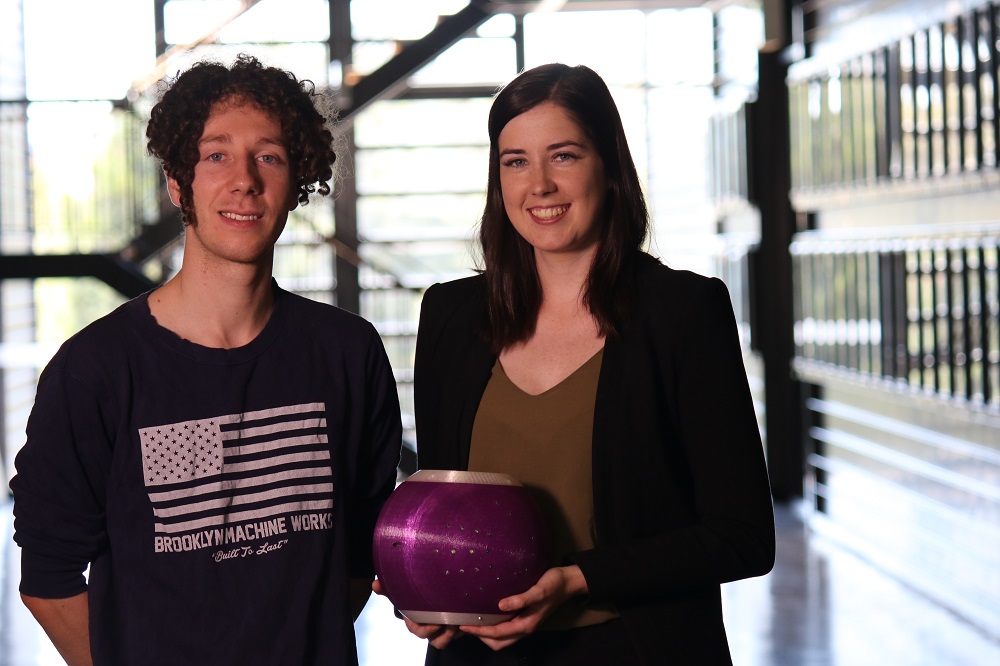Suzanne Lazaroo
20 February 2019: Losing your sense of balance is no small thing.
Whether it’s due to the deterioration of the senses that can come with ageing, or a neurological injury/illness like Parkinson’s disease, a loss of balance often leads to stress, and the kind of debilitating fear of falling that can result in fear of even leaving the house.
“It can really affect your confidence, and therefore your quality of life,” said University of Canberra PhD student Hayley Teasdale, who is specialised in neuroscience.
So together with fellow PhD student David Hinwood (who is specialising in Robotics Engineering), Ms Teasdale developed the Equilibri Balance Ball, to help reduce the risk of falls in those whose balance is impaired.
The idea grew from an earlier study of hers, which used neural stimulation to improve balance.
“At the end of that study, many of our subjects had improved their balance so much that it was clinically significant,” she said.
But more importantly to Ms Teasdale, improving her subjects’ balance had changed their lives.
“They told me stories of how they could now play with their grandchildren, or be confident enough to go out, when they couldn’t before,” she said.
It was enough to drive her to look for a solution that could be accessible and affordable for all.
“As you get older, you rely more on sight to keep your balance, rather than on your other senses, like proprioception,” Ms Teasdale said. This makes it easier for falls to occur in low light conditions, or as eyesight deteriorates.
“The neural pathways that control proprioception, which is the sense of where your body is in space, also diminish from disuse,” Ms Teasdale said.
“So it’s not simply that older people become frail and are therefore more susceptible to falls – there’s more to it than that,” Ms Teasdale said.
“Parkinson’s disease sufferers also have trouble with proprioception, and can have a constant lean because their bodies are struggling to compensate for that,” she added.
The Equilibri Balance Ball works to retrain proprioception, so that your body learns to rely on that sense once again, rather than on sight alone.
Neural pathways are rebuilt. Balance improves. And the likelihood of falls … takes a tumble.
“We’re looking to retrain proprioception where it has deteriorated, but still exists,” Ms Teasdale said. The clinical trials will confirm how much of that sense must remain to an individual, in order for the tool to be effective.
How it works: the Equilibri Balance Ball has two hand-shaped pads on either side that provide sensation to the hands.
“Sensors inside the ball calculate its location in space as users move it around, and the sensor pads vibrate accordingly,” said Ms Teasdale.
The ball is the hardware in the equation.
The “software” is a series of specially-developed exercises to be done with the ball. They’re based on yoga and tai chi movements, and the exercises are safe to do even from a seated position.
The combination aims to retrain pathways through the basal ganglia, the part of the brain that is involved in movement planning and balance.
“That just happens to be my favourite part of the brain!” Ms Teasdale said. “There is much about it that we don’t really understand, but it controls so much of how we move.
“Thanks to its neuroplasticity, the brain can form these new neural connections, and therefore reorganise itself or be retrained, throughout a person’s life.”
According to Ms Teasdale, the Equilibri Balance Ball has been designed to complement existing therapies, such as physiotherapy, physical exercise and fitness classes.
While some of the components for the Equilibri will be made overseas, the products will be assembled in Canberra.
And because the people behind Equilibri are all about maximising positive impact, they’ll be looking to provide employment to the differently-abled via their company.
“We’re big believers in the power of diverse teams,” Ms Teasdale said.
And in the power of dreams-made-robotics, to really change people’s lives.



